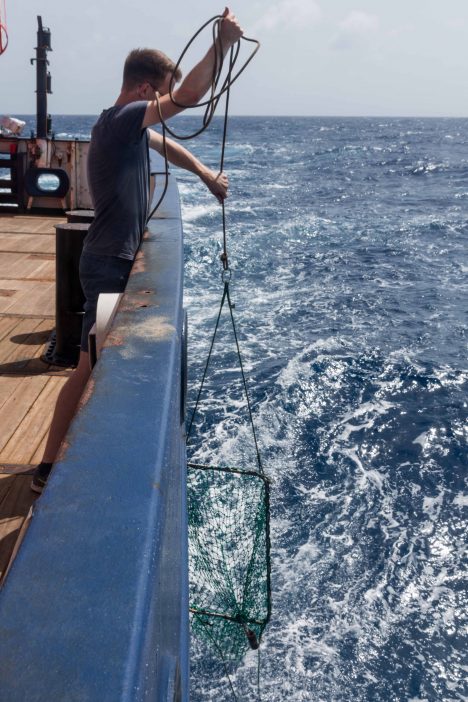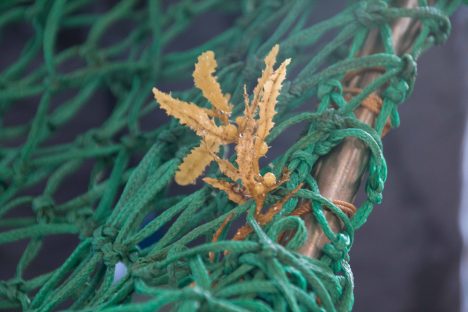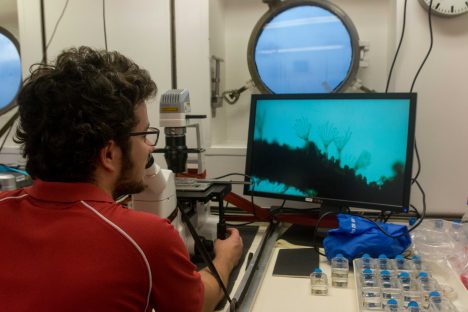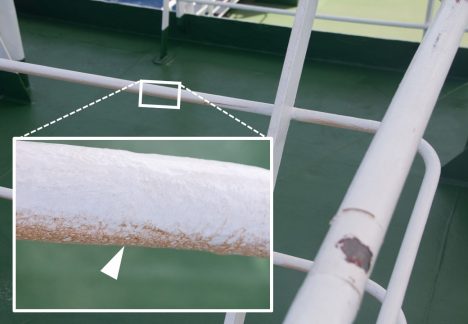Dear interested reader, colleagues, friends and families,
for the moment, let us focus on the water surface rather than the deep sea: We found stretches of brown algae across the ocean surface (Image 1). Free-floating brown algae like Sargassum are distributed worldwide in warm seas. In summer 2015 in the Caribbean, it was reported as the “Sargassum crisis”, which led to the accumulation of algae along the shores in response to rising temperatures of the ocean and the change of ocean currents due to climate change. What must have been just malodorous for tourists, is fascinating for us today. We were glad to salvage three exemplars of Sargassum (Image 2,3) and observe all the life under the microscope (Image 4). Lots of organisms use the brown algae as food, substrate, locomotion vehicle and shelter. It will be interesting, whether the living community on the Sargassum will change under different pressure conditions.
Now let us step aside the water surface and look at the RV Meteor. The ship’s rail is covered with a thin layer of iron-rich sand, which was transported here over thousands of kilometres with the wind from the Sahara Desert (Image 5). Up to 90 % of the iron in the North Atlantic comes from the dust of the Sahara and promotes the carbon fixation by phytoplankton (microscopic algae), which needs the iron for photosynthesis. Phytoplankton is responsible for 45 % of the primary production of the Earth (about 50 x 109 tonnes carbon per year), which in turn feeds zooplankton (animals up to few millimetres in size) and subsequently fish and whales. The drop of atmospheric CO2 concentrations, thus the reduction of the greenhouse gas, leads to the cooling of the planet.
Your M139 team
–
Liebe interessierte Leser, Kollegen, Freunde und liebe Familien,
für einen Augenblick konzentrieren wir uns nicht nur auf die Tiefsee sondern auch auf die Wasseroberfläche: Immer wieder sehen wir lange Straßen von Braunalgen über den Ozean ziehen (Bild 1). Freischwimmende Braunalgen wie Sargassum kommen weltweit in wärmeren Meeren vor. Hier in der Karibik wurde im Sommer 2015 über die sogenannte „Sargassum-Krise“ berichtet, in der vermutlich durch ansteigende Temperaturen des Ozeans und veränderte Strömungen durch den Klimawandel vermehrt Algen an die Küste gespült wurden. Was für Strandtouristen wegen der Faulgase nur zu einem übelriechenden Erlebnis geführt haben muss, freute uns heute, da wir drei Sargassum-Exemplare bergen (Bild 2,3) und das Leben darauf unter dem Mikroskop beobachten konnten (Bild 4). Viele Organismen nutzen die Braunalge als Nahrungssubstrat, Fortbewegungsmittel und Schutz. Es wird weiterhin interessant sein, ob sich die Lebensgemeinschaften auf dem Sargassum bei unterschiedlichen Druckverhältnissen verändern.
Bewegen wir uns nun von der Wasseroberfläche weg und betrachten die FS Meteor. Die Reling des Schiffes trägt eine dünne Schicht aus eisenhaltigem Sand, der viele Tausende Kilometer über die Winde von der Sahara-Wüste hierher transportiert wurde (Bild 5). Über 90 % des Eisens im Nordatlantik stammt vom Staub der Sahara und fördert die Kohlenstofffixierung über Phytoplankton (mikroskopische Algen), welches das Eisen für die Photosynthese benötigt. Phytoplankton ist für 45 % der Primärproduktion der Erde verantwortlich (etwa 50 x 109 Tonnen Kohlenstoff pro Jahr), welches Nahrung für Zooplankton (Tiere bis wenige Millimeter Größe) und später Fische und Wale bietet. Durch die Reduzierung der atmosphärischen CO2-Konzentration, also die Verringerung von Treibhausgasen, wird der Planet kühler.
Ihr M139-Team

Image 1 | Free-floating brown algae (Sargassum) in the Caribbean. (Photo: Johannes Werner)

Image 2 | Fishing Sargassum. (Photo: Johannes Werner)

Image 3 | Sargassum in the net. (Photo: Johannes Werner)

Image 4 | Living community on the surface of Sargassum, here: Bryozoa with tentacles (Moostierchen mit Tentakeln). (Photo: Johannes Werner)

Image 5 | Iron-rich sand originating from the Sahara Desert on the RV Meteor in the Caribbean. (Photo: Johannes Werner)